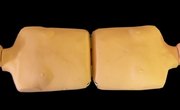A career in veterinary medicine involves years of education and training, as well as passing standardized examinations.
According to the Bureau of Labor Statistics, all United States veterinary colleges require applicants to submit scores from one of three tests: the GRE (Graduate Record Examination); the VCAT exam (Veterinary College Admissions Test); or the MCAT (Medical College Admissions Test). After graduation, veterinarians are also required to pass a standardized licensing exam; some graduates may have to take state standardized tests as well.
Graduate Record Examination (GRE)
According to the Bureau of Labor Statistics, of the 28 accredited veterinary colleges in the United States, 22 of them require applicants to submit GRE scores for admission. The GRE tests students in three basic areas: analytical writing, verbal reasoning and quantitative reasoning.
Students must prove their ability to effectively and clearly articulate complex ideas; they also must be able to evaluate and analyze written excerpts, as well as solve problems in the areas of geometry, arithmetic, algebra and data analysis. As of 2019, the fee for taking the GRE is $205.
VCAT Exam
The Bureau of Labor Statistics reports that 4 of the 28 accredited U.S. veterinary colleges require students to submit scores from the VCAT (Veterinary College Admissions Test). Students are given approximately three hours to answer more than 200 multiple choice questions. Candidates must complete 50 questions in biology, 50 questions in organic and inorganic chemistry, 40 questions in reading comprehension, 40 questions on quantitative reasoning and 50 questions regarding verbal skills. The VCAT is typically offered every year during October and November. Testing fees for the VCAT exam vary; as of 2019, students usually pay between $50 and $65 to take the test.
Medical College Admissions Test (MCAT)
Two of the 28 accredited veterinary colleges in the United States require students to submit scores from the Medical College Admissions Test (MCAT), according to the Bureau of Labor Statistics. The MCAT has three multiple choice sections that test students on the following subjects: verbal reasoning, biological sciences and physical sciences. Students also are required to submit a writing sample. A vet school essay example can be found online to help students create a well-written submission.
MCAT scores average a 30 out of a possible 45 points (15 points per multiple choice section). On a scale of J to T, the average writing score is a P. As of 2019, taking the MCAT costs $315; students may take the test up to three times in one year.
Licensing Exam
Upon graduation from veterinary school, students are required to sit for another rigorous standardized exam to qualify for licensure. The North American Veterinary Licensing Examination is an eight-hour vet school exam comprised of both practical and written questions. This exam is offered during a four-week window in November and December, and during a two-week period in April every year throughout North America and some overseas locations. This vet school test has a national pass rate of 95 percent.
State Exams
Some jurisdictions require veterinarians to sit for state specific standardized examinations as well. These exams test an applicant's veterinary skills, as well as his or her knowledge of state laws and regulations. Each state has its own requirements to keep the veterinarian license in good standing. The Registry of Approved Continuing Education was created by AAVSB to help veterinarians understand which courses are available in their jurisdiction for licensure renewal.
Related Articles
References
Writer Bio
Oubria Tronshaw specializes in topics related to parenting and business. She received a Bachelor of Arts in creative writing from the Santa Fe University of Art and Design, and a Master of Fine Arts in creative writing from Chicago State University. She currently teaches English at Harper Community College in the Chicago area.











